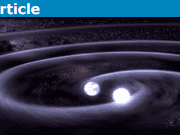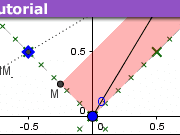The Einstein Field Equation in a Static, Spherically Symmetric Spacetime
This will be the first of several articles which will provide, for reference, useful equations for static, spherically symmetric spacetimes. This is a common special case that is studied in General Relativity, and it has the advantage of having a general solution for the Einstein Field equation that can be expressed in closed form equations. This first article will focus on those closed form equations for that solution.
First, we should be clear about the set of spacetimes we are talking about. The two key properties of this set of spacetimes can be defined in coordinate-independent terms as follows:
(1) A static spacetime has a timelike Killing vector field which is hypersurface orthogonal.
(2) A spherically symmetric spacetime has a 3-parameter group of spacelike Killing vector fields that satisfy the properties of the Lie group SO(3), which describes rotations in 3-dimensional space.
As noted, these definitions are coordinate-independent; they define invariant geometric properties of the spacetime. However, we can make our task much simpler by finding a coordinate chart that matches up well with those properties. Without going into the fine details, we can say that such a chart will have coordinates we label as ##t##, ##r##, ##\theta##, ##\phi##, in which the line element takes the following form:
[tex]ds^2 = – J(r) dt^2 + \frac{1}{1 – \frac{2 m(r)}{r}} dr^2 + r^2 d\theta^2 + r^2 \sin^2 \theta d\phi^2[/tex]
where ##J(r)## and ##m(r)## are two functions of the radial coordinate ##r## whose specific functional forms we will discover by solving the EFE.
We can see that the metric coefficients are independent of all of the coordinates except ##r## and ##\theta##, and ##\theta## only appears in the angular part. That tells us that the coordinate basis vectors ##\partial_t## and ##\partial_\phi## are Killing vectors. If the function ##J(r)## is positive, then ##\partial_t## is timelike and will be the timelike Killing vector field that we know exists because of property #1 above. From the angular part of the line element, we expect that ##\partial_\phi## will be one of the three spacelike Killing vectors that we know exist because of property #2 above. (We will not explicitly find the other two spacelike Killing vectors here; the reader is encouraged to do so as an exercise.)
Also, looking at the angular part of the line element, we can see that a 2-sphere at radial coordinate ##r## will have surface area [itex]4 \pi r^2[/itex]. This is actually not the only possible convention for the radial coordinate, but it is the one that makes the line element look the simplest, and so we will use it here. Coordinates on any spherically symmetric spacetime that use this convention are often referred to as “Schwarzschild coordinates” (even though, ironically, Schwarzschild himself did not use this convention in his original paper).
We have made one more simplification in the above line element: the form of the ##dr^2## term, putting the function ##m(r)## in the denominator in a particular way (which should look familiar to anyone who has seen the Schwarzschild vacuum solution before) instead of just having an unknown function times ##dr^2##, already anticipates the form that the solution of the 0-0 component of the EFE will take. We will discuss that further below.
With our expression for the line element we can compute its Einstein tensor, which gives us the LHS of the EFE. In order to get the RHS, we need expressions for the components of the stress-energy tensor. The key observation to make here is that spherical symmetry places severe constraints on the SET components; in fact the only nonzero components will be:
[tex]T^t{}_t = – \rho (r)[/tex]
[tex]T^r{}_r = p (r)[/tex]
[tex]T^\theta{}_\theta = T^\phi{}_\phi = s (r)[/tex]
Note the minus sign in [itex]T^t_t[/itex]; this is because of the (-+++) metric signature we are using. We use the mixed components because no extra factors involving the metric coefficients appear in them. Also, the spherical symmetry requires that the angular components be equal, but *not* that the spatial stress be isotropic, so the ##r##-##r## component can still be different than the angular components, hence they are shown as two different functions of ##r##.
For reference, we now give the mixed Christoffel symbols for the above line element, even though we will not need them for the rest of this article; only the nonzero ones are listed.
[tex]\Gamma^r{}_{tt} = \frac{r – 2m}{2r} \frac{dJ}{dr}[/tex]
[tex]\Gamma^t{}_{rt} = \Gamma^t{}_{tr} = \frac{1}{2J} \frac{dJ}{dr}[/tex]
[tex]\Gamma^r{}_{rr} = \frac{r \frac{dm}{dr} – m}{r \left( r – 2m \right)}[/tex]
[tex]\Gamma^r{}_{\theta \theta} = 2m – r[/tex]
[tex]\Gamma^r{}_{\phi \phi} = \left( 2m – r \right) \sin^2 \theta[/tex]
[tex]\Gamma^\theta{}_{r \theta} = \Gamma^\theta{}_{\theta r} = \frac{1}{r}[/tex]
[tex]\Gamma^\phi{}_{r \phi} = \Gamma^\phi{}_{\phi r} = \frac{1}{r}[/tex]
[tex]\Gamma^\theta{}_{\theta \phi} = \Gamma^\theta{}_{\phi \theta} = \frac{\cos \theta}{\sin \theta}[/tex]
[tex]\Gamma^\theta{}_{\phi \phi} = – \cos \theta \sin \theta[/tex]
We now look at the EFE components. First is the 0-0 or ##t##-##t## component:
[tex]G^t{}_t = 8 \pi T^t{}_t = – \frac{2}{r^2} \frac{dm}{dr} = – 8 \pi \rho[/tex]
This immediately gives
[tex]\frac{dm}{dr} = 4 \pi r^2 \rho (r)[/tex]
which shows how the form of the [itex]dr^2[/itex] term in the metric arises; if we write that term as just a generic function of ##r##, we find that we can always define a function [itex]m(r)[/itex] that puts it into the form given, without loss of generality. We will defer discussion of the physical meaning of the function ##m(r)## until we have looked at the rest of the EFE components.
Next, the 1-1 or ##r##-##r## component:
[tex]G^r{}_r = 8 \pi T^r{}_r = \frac{1}{r^3 J} \left( r \left( r – 2m \right) \frac{dJ}{dr} – 2 m J \right) = 8 \pi p[/tex]
This leads quickly to an equation for J which is most conveniently written as follows:
[tex]\frac{1}{2J} \frac{dJ}{dr} = \frac{m + 4 \pi r^3 p}{r \left( r – 2m \right)}[/tex]
We would normally look next at the angular components of the EFE; but rather than evaluate them directly (they are both the same, again by spherical symmetry), it turns out to be easier to evaluate the covariant divergence of the SET instead, specifically its ##r##-component, to get an equation including both radial and tangential stress. The general equation is:
[tex]\nabla_a T^a{}_r = \partial_a T^a{}_r + \Gamma^a{}_{ab} T^b{}_r – \Gamma^b{}_{ar} T^a{}_b = 0[/tex]
which gives
[tex]\partial_r T^r{}_r = – \left( \Gamma^t{}_{tr} + \Gamma^r{}_{rr} + \Gamma^\theta{}_{\theta r} + \Gamma^\phi{}_{\phi r} \right) T^r{}_r + \Gamma^t{}_{tr} T^t{}_t + \Gamma^r{}_{rr} T^r{}_r + \Gamma^\theta{}_{\theta r} T^\theta{}_\theta + \Gamma^\phi{}_{\phi r} T^\phi{}_\phi[/tex]
This simplifies, after cancelling terms, substituting, and some algebra, to:
[tex]\frac{dp}{dr} = – \left( \rho + p \right) \frac{1}{2J} \frac{dJ}{dr} – \frac{2}{r} \left( p – s \right)[/tex]
which is recognizable as a generalized form of the Tolman-Oppenheimer-Volkoff equation, i.e., this equation describes hydrostatic equilibrium, how the matter present is supported against its own gravity.
It is worth noting at this point that we have five unknown functions, ##J##, ##m##, ##\rho##, ##p##, and ##s##, but we only have three equations (since there are no other nonzero components of the Einstein Tensor). That means, of course, that there are many possible solutions that satisfy our conditions of staticity and spherical symmetry. To specify a particular solution, we need to specify at least two of our unknown functions: the obvious ones to specify are ##\rho## and ##s##. We will also find that it is helpful to impose other constraints, such as energy conditions, to filter out solutions that are not physically realistic.
Finally, a few comments on physical interpretation. As you have no doubt guessed, the function ##m(r)## can be physically interpreted as the mass inside radial coordinate ##r##. Specifically, we have
$$
m(r) = \int_0^r 4 \pi \rho(r’) (r’)^2 dr’
$$
The interesting thing to note here is that this integral only includes ##\rho##, the density; it does not include the pressure or tangential stress. This might seem contrary to the fairly common statement that, in GR, pressure is a source of gravity. This apparent discrepancy is resolved in my previous series of articles on “Does Gravity Gravitate”.
The function ##J(r)## (or more precisely its square root) has the obvious interpretation of being the “redshift factor” for an observer who is static at radial coordinate ##r##. That is, light emitted by such an observer will be redshifted by this factor when received by a static observer at infinity. Also, if the static observer at ##r## compares his clock rate with that of a static observer at infinity, for example by exchanging round-trip light signals, the static observer at ##r##’s clock will be seen to run slow by the factor ##\sqrt{J(r)}##.
As a final note, we look at the special case where ##\rho = p = s = 0##, i.e., the vacuum case, with no stress-energy present anywhere. For this case, we have ##dm / dr = 0##, which means ##m## is a constant, independent of ##r##, which we will call ##M## for clarity. Using this in the equation for ##J##, we find that ##J = 1 – 2M / r##. In other words, we have shown that any solution of the EFE that is a vacuum, static, spherically symmetric spacetime must be Schwarzschild spacetime. Of course we already know this because of Birkhoff’s theorem, but it provides a useful check on our math above.
In the next article in this series, we will look at Maxwell’s Equations in a static, spherically symmetric spacetime.
- Completed Educational Background: MIT Master’s
- Favorite Area of Science: Relativity










I did this because this was more convenient for me than using the Quote feature.
"
I find this difficult to believe since the Quote feature is very easy to use. Please use it. Standard features like that are there for a reason. Making up your own version undermines that.
"
Does this not mean that m(r) is related to ρ(r)?
"
Yes, and I gave the relationship in the article. It's not the one you are giving here (although later in your post you give the correct one). I'm beginning to wonder if you've actually read the article.
"
I am assuming that the equations
[1] dm/dr = 4πr2 ρ(r)[2] (1/2J) dJ/dr = (m+4πr3p)/(r(r-2m))[3] dp/dr = -(ρ+p)[(1/2J) dJ/dr) – (2(p-s)/r) ]are intended for a universe which may or may not be static. Is this correct?
"
Now I'm beginning to wonder if you've even read the title of the article. What is the seventh word in it?
(Note, btw, that [1] here is the correct relationship between ##m## and ##\rho##. You can integrate it to get ##m(r)## as a function of ##r##, in terms of an integral of ##\rho## from ##0## to ##r##.)
"
I assume for the Einstein 1917 model, pressure p=s=0
"
As far as I know, yes, Einstein assumed cold matter for his static universe, which means the only nonzero term in the stress-energy tensor in the formulation I give in the article would be ##\rho##.
"
These results (implied by p=s=0) makes no sense to me, so I must have made an error (which I cannot find)
"
Then you evidently haven't paid attention very well. See above.
"
This "redshift" factor is what suggested to me that it implied a radial speed associated with distance.
"
"Redshift" here refers to gravitational redshift. This is standard terminology for a static spacetime.
"
That is what lead me to think there was a relationship between J and H.
"
That and the fact that you have repeatedly ignored the word "static".
"
If there is no function of time, the redshift must be only an effect of seeing an object with a redshift corresponding to it kinetic energy. Is that correct?
"
No, it's gibberish. See above on what "redshift" refers to.
"
Does this mean that the static observer sees the energy of something as including the energy equivalent of its mass together with its kinetic energy?
"
Remember we are talking about the stress-energy tensor of a static spacetime. The stress-energy tensor refers to the source of the gravitational field–a planet, star, whatever, which is static. That means a static observer will be at rest relative to this static object. So the object will not have any kinetic energy relative to the static observer. The energy density ##\rho## is just rest energy density.
"
I confess I do not understand why in a homogeneous and isotropic model the tangential and radial pressure should be different.
"
Who said anything about homogenous and isotropic? This Insights article is about a static, spherically symmetric spacetime. Such a spacetime does not have to be homogeneous and isotropic, and in the usual cases, a static gravitating body like a planet or star, it obviously won't be.
I have no idea why you persist in thinking I am describing an FRW spacetime when I have repeatedly explained that I am not.
"
This is a surprise. I did not think that the tensor equations could be specialized for such a static model.
"
Well, then you obviously thought wrong. Also, I have no idea why you would think so.
What would be particularly helpful to my understanding is a description of the physical interpretation of the five functions
"
That is discussed in the article.
"
They are all functions of the radial coordinate r.
"
Yes.
"
J is somehow related to the Hubble function
"
You are mixing up two different kinds of solutions to the EFE. The kind of solution discussed in the Insights article is for a static, spherically symmetric spacetime. There is no "Hubble function" in such a spacetime.
The kind of solution in which there is a "Hubble function" is an FRW spacetime. FRW spacetimes are not static, and nothing in my Insights article applies to them.
"
r(t) is related to a(t)
"
The spacetime discussed in the Insights article is static. Nothing is a function of ##t##. There is no scale factor ##a##. See above.
"
ρ is mass density.
"
More precisely, energy density as measured by a static observer.
"
P is pressure
"
More precisely, radial pressure as measured by a static observer. And ##s## is the tangential pressure (or stress).
"
Einstein set P=0 for his 1917 model of a dust filled universe
"
If you are referring to the Einstein static universe, that (unlike all other spacetimes that can be described in FRW coordinates) is indeed a static, spherically symmetric spacetime, so it can be described using the math in my Insights article. However, that article uses coordinates which are very different from FRW coordinates, so a description of the Einstein static universe using the math in my Insights article will look very different from the usual description of it in FRW coordinates.
"
I do not know what m and s are.
"
Then you didn't read the article very carefully. The meaning of ##m## is discussed near the end. The meaning of ##s## is briefly given in the article, and I gave it again above.
"
I would also like to see a single equation relating H to ρ, m, and s.
"
There isn't one since there is no ##H## in a static spacetime. See above.
I also do not have any idea about what are properties of the Einstein static universe which I do not fully understand.
"
Then I think you would benefit from taking some time to study it. It's a good simple pedagogical model.
the thread I cited
"
Please keep discussion of that thread in that thread.
I would be very interested to see the form of the EFE you are using.
"
Then you can read my Insights article on the Einstein Field Equation in a static, spherically symmetric spacetime. You know, the one this comment thread is about.
"
Apparently, in the June 5th article, you have not yet introduced that EFE.
"
Are you referring to the Insights article? What do you think is missing from it?
I would much appreciate your taking a look at my calculations regarding a finite static stable universe
"
You seem to be reinventing the Einstein static universe without fully understanding its properties. The feedback you are getting in the thread looks valid to me.
In any case, the form of the EFE you are using in that thread is different from the form I use in the article.
##\partial_{\theta}## is NOT a killing vector here.
"
You're right, I have updated the article to correct this.
"
I believe the correct formulation is that the redshift factor is proportional to ##\sqrt{J(r)}## and not ##J(r)##.
"
It is ##\sqrt{J(r)}##, that's correct. (There is no constant of proportionality required.) I've updated the article to fix this as well.
"
It would also be great if you could illustrate the definition of '##s##' in the TOV equation as this seems to have been introduced without adequate precedent.
"
I'm not sure what you mean by "inadequate precedent". The TOV equation is derived assuming that the matter present is a perfect fluid; that means all three spatial diagonal components of the SET must be equal. If you drop that assumption, the radial component can be different from the tangential components, but the two tangential components still need to be the same by spherical symmetry. That's why there are just two functions, ##p## and ##s##.
I bit pedantic but shouldn't the definition of spherically symmetric be phrased differently. The Killing fields generate a Lie algebra isomorphic to ##\mathfrak{so}(3)##, the group of isometries is ##\text{SO}(3)##.
"
I think this might be a bit too much detail; I was trying to avoid going into it by saying the Killing fields "satisfy the properties" of ##\text{SO}(3)## (the Lie algebra would be part of the "properties").
Did you have a particular question about the SET and constraints on it?
"
Not really anything specific. The stress-energy tensor seems to me to be something GR texts often seem to assume you understand, somehow. I think I may have missed a lecture somewhere, because it's the bit I feel I have the least grasp of. So I'm always interested in seeing someone talking about it.
Are you going to go more into the stress-energy tensor and the constraints on it in this case in later articles?
"
I wasn't planning to. One further article will give Maxwell's Equations in a static, spherically symmetric spacetime (and how they couple to the EFE via the stress-energy tensor for an EM field), and another will give equations for an object being slowly lowered in a static, spherically symmetric spacetime.
Did you have a particular question about the SET and constraints on it?
A question from Reddit
"
I suspect the question is from a person who does not really have the background knowledge to understand the post. Here is a suggested reply:
The gammas are Christoffel symbols [1]; the three indexes are tensor indexes, not variables. The upper index is not an exponent; it's an upper tensor index. (Strictly speaking the Christoffel symbols are not tensors, but they have tensor indexes and are treated like tensors in formulas.) Like all other quantities in the case under discussion, the Christoffel symbols are functions of only one variable, ##r##, because of the staticity and spherical symmetry.
[1] https://en.wikipedia.org/wiki/Christoffel_symbols
"
Are the gammas with an exponent and two indexes a three variable function ?
"